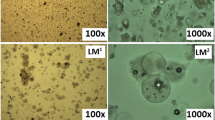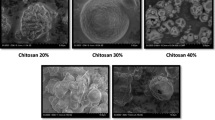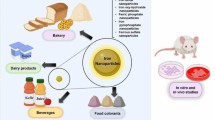Abstract
Iron fortification in food is considered as an important way to prevent and treat iron deficiency. However, adding iron in food can affect flavor, color, and oxidation of fat components. Encapsulation of iron can solve the drawbacks of taste, color, and reactivity of iron in oral iron consumption without adverse effect on food quality. The aim of this work was to nanoencapsulate iron into pectin (Pec) nanoparticles (NP) by ion gelation method to prevent undesirable sensorial changes in foods and improve bioavailability of iron. The effect of different parameters including pectin concentration (Pec Con), FeSO4 concentration (Fe Con), and volumetric ratio of Fe solution to Pec solution on iron loaded Pec nanoparticles (IP NP) size was investigated. Morphology, size, surface charge, and physicochemical features of the optimized particles were characterized. The iron released from IP NP was studied, and the mathematical model of release was extracted. Pec Con exhibited a direct effect on particle size. The optimized IP NP (Pec solution 0.1% (w/w), Fe solution 0.05% (w/w), and Pec/Fe: 2) had a hydrodynamic diameter of 417 nm with zeta potential of −11.7 mV and polydispersity index (PDI) of 0.13, with a nearly spherical morphology. Scanning electron microscopy (SEM) represented the mean size of 58 nm. Iron loading was about 7.5 ± 1.5%. FTIR results confirmed the interaction of iron ions with the hydroxyl and carboxyl groups of Pec. The results of differential scanning calorimetric (DSC) indicated the interaction of Pec with iron. The release profile of iron in all pH of 2, 6, and 7.4 showed a burst release at the beginning and then a sustained release occurred. In all three pH values, the mathematical model of release was Korsmeyer-Peppas with the highest R2 value. Therefore, encapsulation of iron using pectin have a high potential to make nanoparticles with appropriate properties, which can be helpful for iron fortification of food.







Similar content being viewed by others
Data Availability
All data generated or analyzed during this study are included in this manuscript.
References
Aberkane, L., Roudaut, G., & Saurel, R. (2014). Encapsulation and oxidative stability of PUFA-rich oil microencapsulated by spray drying using pea protein and pectin. Food and Bioprocess Technology, 71505–1517.
Adabi, M., Saber, R., Adabi, M., & Sarkar, S. (2011). Examination of incubation time of bare gold electrode inside cysteamine solution for immobilization of multi-walled carbon nanotubes on a gold electrode modified with cysteamine. Microchimica Acta, 172(1), 83–88.
Almasi, K., Esnaashari, S. S., Khosravani, M., & Adabi, M. (2021). Yogurt fortified with omega-3 using nanoemulsion containing flaxseed oil: Investigation of physicochemical properties. Food Science & Nutrition, 9(11), 6186–6193.
Assadpour, E., Maghsoudlou, Y., Jafari, S.-M., Ghorbani, M., & Aalami, M. (2016). Evaluation of folic acid nano-encapsulation by double emulsions. Food and Bioprocess Technology, 9(12), 2024–2032.
Bashir, O., Bhat, S. A., Basharat, A., Qamar, M., Qamar, S. A., Bilal, M., & Iqbal, H. M. (2022a). Nano-engineered materials for sensing food pollutants: Technological advancements and safety issues. Chemosphere, 292, 133320.
Bashir, O., Rashid, S., Masoodi, N., Khan, S. A., Majid, I., & Malik, M. (2022b). Nanocellulose: Chemistry, preparation, and applications in the food industry (pp. 155–177). Elsevier.
Bathla, S., & Arora, S. (2022). Prevalence and approaches to manage iron deficiency anemia (IDA). Critical Reviews in Food Science and Nutrition, 62(32), 8815–8828.
Boanares, D., Ferreira, B., Kozovits, A., Sousa, H., Isaias, R., & França, M. (2018). Pectin and cellulose cell wall composition enables different strategies to leaf water uptake in plants from tropical fog mountain. Plant Physiology and Biochemistry, 122, 57–64.
Bryszewska, M. A. (2019). Comparison study of iron bioaccessibility from dietary supplements and microencapsulated preparations. Nutrients, 11(2), 273.
Buyukkestelli, H. I., & El, S. N. (2019). Development and characterization of double emulsion to encapsulate iron. Journal of Food Engineering, 263, 446–453.
Chaichi, M., Hashemi, M., Badii, F., & Mohammadi, A. (2017). Preparation and characterization of a novel bionanocomposite edible film based on pectin and crystalline nanocellulose. Carbohydrate polymers, 157, 167–175.
Chittasupho, C., Jaturanpinyo, M., & Mangmool, S. (2013). Pectin nanoparticle enhances cytotoxicity of methotrexate against hepG2 cells. Drug Delivery, 20(1), 1–9.
Dekkers, B. L., Hamoen, R., Boom, R. M., & van der Goot, A. J. (2018). Understanding fiber formation in a concentrated soy protein isolate-pectin blend. Journal of Food Engineering, 222, 84–92.
Esfanjani, A. F., Assadpour, E., & Jafari, S. M. (2018). Improving the bioavailability of phenolic compounds by loading them within lipid-based nanocarriers. Trends in Food Science & Technology, 76, 56–66.
Esnaashari, S. S., & Amani, A. (2018). Optimization of noscapine-loaded mPEG-PLGA nanoparticles and release study: A response surface methodology approach. Journal of Pharmaceutical Innovation, 13(3), 237–246.
Esnaashari, S. S., Muhammadnejad, S., Amanpour, S., & Amani, A. (2020). A combinational approach towards treatment of breast cancer: An analysis of noscapine-loaded polymeric nanoparticles and doxorubicin. An Official Journal of the American Association of Pharmaceutical Scientists, 21(5), 1–12.
Gharsallaoui, A., Saurel, R., Chambin, O., Cases, E., Voilley, A., & Cayot, P. (2010). Utilisation of pectin coating to enhance spray-dry stability of pea protein-stabilised oil-in-water emulsions. Food Chemistry, 122(2), 447–454.
Ghibaudo, F., Gerbino, E., Hugo, A. A., Simões, M., Alves, P., Costa, B. F., Orto, V. C. D., Gómez-Zavaglia, A., & Simoes, P. N. (2018). Development and characterization of iron-pectin beads as a novel system for iron delivery to intestinal cells. Colloids and Surfaces B: Biointerfaces, 170, 538–543.
Gupta, C., Chawla, P., & Arora, S. (2015). Development and evaluation of iron microencapsules for milk fortification. CyTA-Journal of Food, 13(1), 116–123.
Habeych, E., van Kogelenberg, V., Sagalowicz, L., Michel, M., & Galaffu, N. (2016). Strategies to limit colour changes when fortifying food products with iron. Food Research International, 88, 122–128.
Hatefi, L., & Farhadian, N. (2020). A safe and efficient method for encapsulation of ferrous sulfate in solid lipid nanoparticle for non-oxidation and sustained iron delivery. Colloid and Interface Science Communications, 34, 100227.
Hosny, K. M., Banjar, Z. M., Hariri, A. H., & Hassan, A. H. (2015). Solid lipid nanoparticles loaded with iron to overcome barriers for treatment of iron deficiency anemia. Drug Design, Development and Therapy, 9, 313.
Hurrell, R. F. (2021). Iron fortification practices and implications for iron addition to salt. The Journal of Nutrition, 151(Supplement_1), 3S-14S.
Jacob, E. M., Borah, A., Jindal, A., Pillai, S. C., Yamamoto, Y., Maekawa, T., & Kumar, D. N. S. (2020). Synthesis and characterization of citrus-derived pectin nanoparticles based on their degree of esterification. Journal of Materials Research, 35(12), 1514–1522.
Jafari, S. M., Katouzian, I., Rajabi, H., & Ganje, M. (2017). Bioavailability and release of bioactive components from nanocapsules (pp. 494–523). Elsevier.
Jafari, S. M., Vakili, S., & Dehnad, D. (2019). Production of a functional yogurt powder fortified with nanoliposomal vitamin D through spray drying. Food and Bioprocess Technology, 12, 1220–1231.
Jash, A., Krueger, A., & Rizvi, S. S. (2022). Venturi-based rapid expansion of supercritical solution (Vent-RESS): Synthesis of liposomes for pH-triggered delivery of hydrophilic and lipophilic bioactives. Green Chemistry, 24(13), 5326–5337.
Joel, J., Barminas, J., Riki, E., Yelwa, J., & Edeh, F. (2018). Extraction and characterization of hydrocolloid pectin from goron tula (Azanza garckeana) fruit. world scientific news, (101), 157–171.
Jonassen, H., Treves, A., Kjøniksen, A.-L., Smistad, G., & Hiorth, M. (2013). Preparation of ionically cross-linked pectin nanoparticles in the presence of chlorides of divalent and monovalent cations. Biomacromolecules, 14(10), 3523–3531.
Kabakci, C., Sumnu, G., Sahin, S., & Oztop, M. H. (2021). Encapsulation of magnesium with lentil flour by using double emulsion to produce magnesium enriched cakes. Food and Bioprocess Technology, 14, 1773–1790.
Katuwavila, N. P., Perera, A., Dahanayake, D., Karunaratne, V., Amaratunga, G. A., & Karunaratne, D. N. (2016). Alginate nanoparticles protect ferrous from oxidation: Potential iron delivery system. International Journal of Pharmaceutics, 513(1–2), 404–409.
Keawchaoon, L., & Yoksan, R. (2011). Preparation, characterization and in vitro release study of carvacrol-loaded chitosan nanoparticles. Colloids and Surfaces B, 84(1), 163–171.
Kiskini, A., Kapsokefalou, M., Yanniotis, S., & Mandala, I. (2012). Effect of iron fortification on physical and sensory quality of gluten-free bread. Food and Bioprocess Technology, 5, 385–390.
Kumari, A., & Chauhan, A. K. (2022). Iron nanoparticles as a promising compound for food fortification in iron deficiency anemia: A review. Journal of Food Science and Technology, 59(9), 3319–3335.
Mehansho, H. (2006). Iron fortification technology development: New approaches. The Journal of Nutrition, 136(4), 1059–1063.
Min, K. A., Cho, J.-H., Song, Y.-K., & Kim, C.-K. (2016). Iron casein succinylate-chitosan coacervate for the liquid oral delivery of iron with bioavailability and stability enhancement. Archives of Pharmacal Research, 39, 94–102.
Mishra, R. K., Datt, M., & Banthia, A. K. (2008). Synthesis and characterization of pectin/PVP hydrogel membranes for drug delivery system. Aaps Pharmscitech, 9, 395–403.
Mohammadian, M., Waly, M. I., Moghadam, M., Emam-Djomeh, Z., Salami, M., & Moosavi-Movahedi, A. A. (2020). Nanostructured food proteins as efficient systems for the encapsulation of bioactive compounds. Food Science and Human Wellness, 9(3), 199–213.
Motwani, S. K., Chopra, S., Talegaonkar, S., Kohli, K., Ahmad, F. J., & Khar, R. K. (2008). Chitosan–sodium alginate nanoparticles as submicroscopic reservoirs for ocular delivery: Formulation, optimisation and in vitro characterisation. European Journal of Pharmaceutics and Biopharmaceutics, 68(3), 513–525.
Muthukrishnan, L. (2022). Nanonutraceuticals—Challenges and novel nano-based carriers for effective delivery and enhanced bioavailability. Food and Bioprocess Technology, 15(10), 2155–2184.
Nawrocka, A., Szymańska-Chargot, M., Miś, A., Wilczewska, A. Z., & Markiewicz, K. H. (2017). Effect of dietary fibre polysaccharides on structure and thermal properties of gluten proteins–A study on gluten dough with application of FT-Raman spectroscopy, TGA and DSC. Food Hydrocolloids, 69, 410–421.
Opanasopit, P., Apirakaramwong, A., Ngawhirunpat, T., Rojanarata, T., & Ruktanonchai, U. (2008). Development and characterization of pectinate micro/nanoparticles for gene delivery. An Official Journal of the American Association of Pharmaceutical Scientists, 9(1), 67–74.
Patil, S. S., Khanwelkar, C. C., & Patil, S. (2012). Conventional and newer oral iron preparations. International Journal Medicine of Pharmaceutical Science, 216–22.
Perumal, P., Christopher Selvin, P., & Selvasekarapandian, S. (2018). Characterization of biopolymer pectin with lithium chloride and its applications to electrochemical devices. Ionics, 24(10), 3259–3270.
Pitarresi, G., Tripodo, G., Cavallaro, G., Palumbo, F. S., & Giammona, G. (2008). Inulin–iron complexes: A potential treatment of iron deficiency anaemia. European Journal of Pharmaceutics and Biopharmaceutics, 68(2), 267–276.
Pratap Singh, A., Siddiqui, J., & Diosady, L. L. (2018). Characterizing the pH-dependent release kinetics of food-grade spray drying encapsulated iron microcapsules for food fortification. Food and Bioprocess Technology, 11, 435–446.
Saffarionpour, S., & Diosady, L. L. (2021). Multiple emulsions for enhanced delivery of vitamins and iron micronutrients and their application for food fortification. Food and Bioprocess Technology, 14, 587–625.
Saffarionpour, S., & Diosady, L. L. (2022). Delivery of ferric sodium EDTA by water-in-oil-in-water (W1/O/W2) double emulsions: Influence of carrier oil on its in vitro bioaccessibility. Food and Bioprocess Technology, 15(2), 421–439.
Seethu, B., Pushpadass, H. A., Emerald, F. M. E., Nath, B. S., Naik, N. L., & Subramanian, K. (2020). Electrohydrodynamic encapsulation of resveratrol using food-grade nanofibres: Process optimization, characterization and fortification. Food and Bioprocess Technology, 13, 341–354.
Shilpashree, B., Arora, S., Kapila, S., & Sharma, V. (2020). Whey protein-iron or zinc complexation decreases pro-oxidant activity of iron and increases iron and zinc bioavailability. Lwt, 126, 109287.
Shin, G. H., Kim, J. T., & Park, H. J. (2015). Recent developments in nanoformulations of lipophilic functional foods. Trends in Food Science & Technology, 46(1), 144–157.
Shubham, K., Anukiruthika, T., Dutta, S., Kashyap, A., Moses, J. A., & Anandharamakrishnan, C. (2020). Iron deficiency anemia: A comprehensive review on iron absorption, bioavailability and emerging food fortification approaches. Trends in Food Science & Technology, 99, 58–75.
Sriamornsak, P. (2011). Application of pectin in oral drug delivery. Expert Opinion on Drug Delivery, 8(8), 1009–1023.
Wang, Q., Zhang, L., Ding, W., Zhang, D., Reed, K., & Zhang, B. (2020). Orthogonal optimization and physicochemical characterization of water-soluble gelatin-chitosan nanoparticles with encapsulated alcohol-soluble eugenol. Food and Bioprocess Technology, 13, 1024–1034.
Yan, J.-K., Qiu, W.-Y., Wang, Y.-Y., & Wu, J.-Y. (2017). Biocompatible polyelectrolyte complex nanoparticles from lactoferrin and pectin as potential vehicles for antioxidative curcumin. Journal of Agriculture and Food Chemistry, 65(28), 5720–5730.
Yu, C.-Y., Cao, H., Zhang, X.-C., Zhou, F.-Z., Cheng, S.-X., Zhang, X.-Z., & Zhuo, R.-X. (2009). Hybrid nanospheres and vesicles based on pectin as drug carriers. Langmuir, 25(19), 11720–11726.
Yu, Y.-T., Peng, J.-H., Liu, B.-G., Chen, G., & Srinivasakannan, C. (2013). Investigation on preparation of micro-sized hematite powder from hydrous ferrous sulfate using microwave and conventional heating. High Temperature Materials and Processes, 32(3), 303–308.
Acknowledgements
We thank the Tehran Medical Sciences, Islamic Azad University for supporting this project.
Author information
Authors and Affiliations
Contributions
Ensi Gholam Jamshidi: investigation, Farahnaz Behzad: writing—original draft, Mahdi Adabi: conceptualization, writing—review and editing, Seyedeh Sara Esnaashari: conceptualization, writing—review and editing, supervision.
Corresponding author
Ethics declarations
Conflict of Interest
The authors declare no competing interests.
Additional information
Publisher's Note
Springer Nature remains neutral with regard to jurisdictional claims in published maps and institutional affiliations.
Rights and permissions
Springer Nature or its licensor (e.g. a society or other partner) holds exclusive rights to this article under a publishing agreement with the author(s) or other rightsholder(s); author self-archiving of the accepted manuscript version of this article is solely governed by the terms of such publishing agreement and applicable law.
About this article
Cite this article
Gholam Jamshidi, E., Behzad, F., Adabi, M. et al. Edible Iron-Pectin Nanoparticles: Preparation, Physicochemical Characterization and Release Study. Food Bioprocess Technol 17, 628–639 (2024). https://doi.org/10.1007/s11947-023-03156-4
Received:
Accepted:
Published:
Issue Date:
DOI: https://doi.org/10.1007/s11947-023-03156-4




